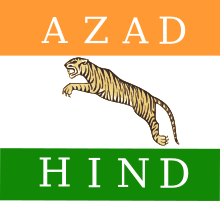Mohammed Zaman Kiani
Major-General Mohammed Zaman Kiani (1 October 1910 – 4 June 1981) was an officer of the British Indian Army who later joined the Indian National Army and was appointed its Chief of General Staff.
Early life
According to Justice Muhammad Yusuf Saraf, Zaman Kiani was from Islamabad (Anantnag) in Kashmir.[1]
A keen hockey player in his youth, Kiani joined the British Indian Army in 1931 at the Indian Military Academy at Dehra Dun, sitting for the entrance exam in preference to attending Olympic Hockey trials in Calcutta.[2] He won Sword of Honour & Gold Medal for the most outstanding Cadet in 1935 from Indian Military Academy, and was commissioned a Second Lieutenant on the Special List 15 July 1935 and attached to the 2nd battalion, Highland Light Infantry as of 10 August 1935.[3] He joined the 1st Battalion 14th Punjab Regiment as a Second Lieutenant 24 January 1936, and was promoted Lieutenant 4 May 1936.[4]
Second World War
In March 1941 the 1st Battalion 14th Punjab Regiment was sent to Malaya and he fought in the Malayan theatre during World War II and was taken prisoner of war. He later joined the Indian National Army (INA) when it was formed in 1942 and was put in charge of the INA at the time of its revival in February 1943. After the proclamation of Azad Hind under Subhas Chandra Bose, Kiani was appointed the commander of the first division, and later went on to be appointed the Chief of General staff.[5] which had been earlier held by Lt. Col J.K. Bhonsle.[6] At the time of the fall of Rangoon, Kiani led the personnel of the Indian National Army and the Azad Hind Government who, along with Subhas Chandra Bose, marched overland to Bangkok.[5]
Kiani surrendered to the British 5th Division at Singapore on 25 August 1945 as the commander of the INA, along with the rest of his troops.[7] He was repatriated to India and interned till 1946 before being cashiered and discharged from the army.[8]
First Kashmir War
Following the Partition of India, Kiani migrated to Rawalpindi after the independence of Pakistan in 1947.
In September 1947, Pakistan Prime Minister Liaquat Ali Khan and the Pubjab minister Shaukat Hayat Khan put him in charge of the southern wing of the Pakistan's effort to overthrow the government of the Maharaja of Jammu and Kashmir. General Kiani established a General Headquarters, GHQ Azad, based in Gujrat. From here, Kiani's forces organized raiding operations on Kashmir border and directed the Azad rebels in Poonch. Brigadier Habibur Rehman served as his Chief of Staff.
Late life
Kiani was later appointed the Political agent of the Government of Pakistan at Gilgit.[8] He wrote his memoirs while in retirement in Rawalpindi. They were published after his death:
- Kiani, M. Z. (1994), India's Freedom Struggle and The Great INA - Memoirs of Maj Gen Mohammad Zaman Kiani Foreword by Sisir Kumar Bose., Reliance Publishing House.New Delhi, ISBN 81-85972-04-4
References
Sources
- Bose, Sugata (2009), A Hundred Horizons: The Indian Ocean in the Age of Global Empire, Harvard University Press, ISBN 978-0-674-02857-9
- Mercado, Stephen C. (2002), The Shadow Warriors of Nakano: A History of the Imperial Japanese Army's elite intelligence school., Brassey's., ISBN 1-57488-538-3
- Saraf, Muhammad Yusuf (2015) [first published 1979 by Ferozsons], Kashmiris Fight for Freedom, Volume 2, Mirpur: National Institute Kashmir Studies
External links
- Extract from Sugata Bose, A Hundred Horizons, world-journal.net, archived on 6 October 2007.
